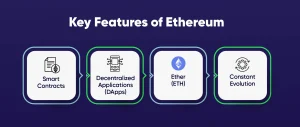Ethereum 2.0, also known as ETH 2.0 or Serenity, represents a significant upgrade to the Ethereum blockchain, aiming to improve its scalability, security, and sustainability. This transition from Ethereum’s current proof-of-work (PoW) consensus mechanism to a proof-of-stake (PoS) model is set to have profound implications for the broader cryptocurrency ecosystem. Here’s an overview of what Ethereum 2.0 entails and its potential impact.
Key Features of Ethereum 2.0

1. Transition to Proof of Stake (PoS)
- Energy Efficiency: PoS significantly reduces the energy consumption associated with mining, addressing environmental concerns linked to PoW.
- Validator System: Instead of miners, Ethereum 2.0 uses validators who stake their ETH to secure the network, making it more inclusive and less resource-intensive.
2. Sharding
- Scalability: Sharding involves breaking the Ethereum blockchain into smaller, more manageable pieces (shards) that can process transactions and smart contracts independently. This increases the network’s throughput and efficiency.
- Parallel Processing: By enabling multiple shards to operate simultaneously, Ethereum can handle a greater volume of transactions, enhancing user experience.
3. Beacon Chain
- Coordination Layer: The Beacon Chain serves as the backbone of Ethereum 2.0, coordinating the network and managing the PoS protocol.
- Reward Mechanism: It will implement mechanisms to reward validators for their contributions to network security and performance.
4. Improved Security
- Economic Security: The PoS model is expected to enhance security by making it costly for malicious actors to attack the network, as they would need to own a significant amount of ETH.
- Slashing Mechanism: Validators can lose part of their staked ETH as a penalty for dishonest behavior, further incentivizing honest participation.
Impact on the Crypto Ecosystem

1. Enhanced Scalability
- Increased Adoption: With improved transaction speed and capacity, Ethereum 2.0 can support a wider range of decentralized applications (dApps), driving further adoption across various sectors, including finance, gaming, and supply chain management.
2. DeFi Growth
- Decentralized Finance (DeFi): Ethereum has been the foundation for much of the DeFi movement. Enhancements in scalability and transaction efficiency will facilitate the growth of more complex financial products and services on the Ethereum network.
3. NFTs and Digital Ownership
- Non-Fungible Tokens (NFTs): The NFT market, which relies heavily on Ethereum, will benefit from faster transactions and lower fees, making it easier for artists and creators to mint, buy, and sell NFTs.
4. Competitive Landscape
- Rival Blockchains: As Ethereum 2.0 matures, it may strengthen Ethereum’s position against competing blockchains like Binance Smart Chain, Solana, and Cardano. However, these blockchains will continue to innovate, leading to a dynamic and competitive environment.
5. Regulatory Considerations
- Focus on Compliance: As Ethereum transitions to PoS, it may attract regulatory scrutiny regarding the classification of staking rewards and the implications for securities laws, influencing how DeFi projects operate.
6. Community and Ecosystem Development
- Increased Participation: The shift to PoS may encourage more community involvement, with individuals able to stake relatively small amounts of ETH to become validators, fostering a more decentralized and engaged ecosystem.
Conclusion
Ethereum 2.0 represents a pivotal moment in the evolution of the Ethereum network and the broader cryptocurrency landscape. By enhancing scalability, security, and sustainability, it aims to solidify Ethereum’s position as a leading platform for decentralized applications and services. As the transition unfolds, the crypto ecosystem will likely experience significant changes, with increased adoption, innovation, and potential challenges related to regulation and competition. The success of Ethereum 2.0 could set a precedent for other blockchain projects, influencing the future direction of the entire industry.


